The Revival of Baroque Dance in Contemporary Performance Art

Understanding Baroque Dance: A Brief Overview
Baroque dance, popular from the late 16th to the early 18th century, is characterized by its elaborate movements and intricate choreography. Originating alongside the Baroque period in art and music, this dance form was often performed in royal courts, making it a symbol of elegance and sophistication. It blends rhythmic precision with expressive gestures, creating a visual feast that captivates audiences even today. Understanding its historical context helps us appreciate its revival in contemporary settings.
The Reasons Behind the Revival of Baroque Dance
The revival of Baroque dance in contemporary performance art can be attributed to a growing interest in historical practices and aesthetics. Artists are increasingly drawn to the richness of Baroque movement, which offers a unique contrast to modern dance styles. This resurgence is also fueled by a desire to explore themes of nostalgia and cultural heritage, as performers seek to connect with the past while creating something new. The interplay of old and new creates a dynamic landscape for artistic expression.
Revival Driven by Historical Interest
The resurgence of Baroque dance is fueled by a growing fascination with historical practices and a desire to explore cultural heritage.
Contemporary Choreographers Embracing Baroque Elements
Many contemporary choreographers are incorporating Baroque elements into their works, blending classical and modern styles seamlessly. For instance, choreographers like Anne Teresa De Keersmaeker and William Forsythe have drawn inspiration from Baroque principles, reinterpreting them for today’s audiences. Their works showcase how Baroque dance can inform contemporary movement, enriching the overall choreography with depth and complexity. This fusion not only pays homage to the past but also revitalizes it for modern sensibilities.
Baroque Dance and Its Impact on Modern Performance
The integration of Baroque dance into modern performances has led to a refreshing reimagining of theatrical expressions. Performers are using Baroque techniques to enhance storytelling, adding layers of emotion through precise movements and gestures. This approach allows artists to engage audiences in new ways, captivating them with the beauty of historical movement while addressing contemporary themes. As a result, Baroque dance is not just a relic of the past but a dynamic force in today's performance art landscape.
Contemporary Fusion with Baroque Dance
Modern choreographers are blending Baroque elements with contemporary styles, enriching performances with depth and complexity.
The Role of Music in Baroque Dance Revival
Music plays a pivotal role in the revival of Baroque dance, as the genre is deeply intertwined with the compositions of the time. Contemporary performances often feature live music that echoes the Baroque style, enhancing the visual experience with rich auditory textures. Composers and musicians are exploring Baroque pieces and creating new compositions that honor its spirit while appealing to modern tastes. This harmonious blend of movement and sound invites audiences to immerse themselves fully in the experience.
Educational Initiatives Promoting Baroque Dance
Various educational initiatives are emerging to promote Baroque dance and its historical significance. Workshops, masterclasses, and performances are being organized by dance schools and cultural institutions, aimed at both professionals and enthusiasts. These programs not only teach the techniques of Baroque dance but also explore its cultural context, fostering a deeper appreciation. By educating new generations of dancers, these initiatives ensure that the revival of Baroque dance continues to thrive and evolve.
Education Ensures Baroque's Future
Educational initiatives are promoting Baroque dance, fostering appreciation and training new generations of dancers to keep the art form alive.
Challenges in Reviving Historical Dance Forms
While the revival of Baroque dance is exciting, it does come with its set of challenges. One major difficulty is balancing authenticity with innovation, as artists strive to remain true to historical practices while still engaging contemporary audiences. Additionally, the physical demands of Baroque dance require rigorous training, which can be intimidating for those unfamiliar with its intricacies. Overcoming these challenges is essential for the successful integration of Baroque dance into modern performance art.
The Future of Baroque Dance in Performance Art
Looking ahead, the future of Baroque dance in performance art appears promising, with a growing community of artists dedicated to its exploration. As more choreographers and performers experiment with its elements, we can expect to see innovative interpretations that keep the spirit of Baroque alive. The dialogue between past and present will continue to inspire creativity, leading to unique performances that resonate with diverse audiences. Ultimately, Baroque dance has the potential to carve out a distinctive niche in the contemporary art scene.